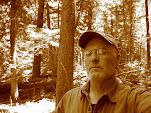I got up this morning and checked the weather forecast, and it was not good with a prediction for 10-15 mph winds with gusts of 20. I was ready to stay in, hiding from the cloudy gloom, but everything changed, or more accurately, enough things changed. An hour later, looking out the window, it seemed to be fairly calm. I looked at the forecast again, and the wind and gust predictions had all but disappeared. It'll be my first drysuit day of the season. The water temperature is in the fifties at this point, and if it rains, the drysuit will be the perfect layer.
I put in under the high bridge. Nearby, a tug is tending two barges and by the time I head down, a pair of smaller powerboats are pushing one of the barges upstream with the flood tide assisting. It seems a little risky to me to trust that barge to the small boats, but who am I to argue.
I get down to the marsh in reasonable time and head into the Nell's Island maze using the most upstream entrance. The tide is middling with about 3 more feet to rise. I am not sure if the maze will be passable at this level, but it is a good day to find out - the deeper channels will stand out. The deadfall blockage that was in the upstream entrance since summer has floated off to who knows where.
The spartina is turning yellow-gold. This makes the glass-wort stand out, no longer both green, the glass-wort is turning reddish and stands out against the yellowing spartina. Even with the thick and low overcast, the marsh is spectacular.
 |
| The usual deadfall bypass |
There is one semi-obvious (at least if you've been through before) route from between the top and bottom of Nell's Island. There is a blocking deadfall, which will probably not change for a year or two, but nearby is a short, narrow and shallow bypass that I use regularly. However, the bypass is not flooded yet with several inches of muddy goo exposed over the 15 yard length. Earlier this year, I found a second route through the island but I haven't been able to locate it again. This is a good excuse to spend the time hunting for it (looking for passages is best when the tide is high or still rising - it gives you time to back out of long dead ends).
 |
| The missing alternative route |
I head back to the west and come to choice between two open channels. I take the left one, for no real reason. It keeps going, gradually narrowing, and twisting to either side. Just as it looks like it will peter out, it opens up again. That is rather typical with salt marsh channels as the tidal currents will enter the channel from either end and stagnate somewhere in the middle, and of course any sediment is prone to settling there. So, I have found the missing alternative route and the only trick will be to remember how to get to it later on.

Back in the main lower exit, it is about as calm as calm could be. I have flushed a couple Great Blue Herons and a few Black Ducks. I head to Milford Point for a short break, spot a solitary Dunlin, then cross the marsh to the east shore, flush some more Black Ducks and a dozen migratory Canada Geese. Head into the Central Phragmites patch, finding and collecting a lost Coot decoy (I've never seen a Coot decoy before), and then paddle up and into Beaver Brook. There, I flush about forty Ducks, a mix of Blacks and Mallards.
It begins to mist lightly as I head back out and once I get to the main river, a west wind comes in. It is just barely starting to rain when I get back to my put-in.




























